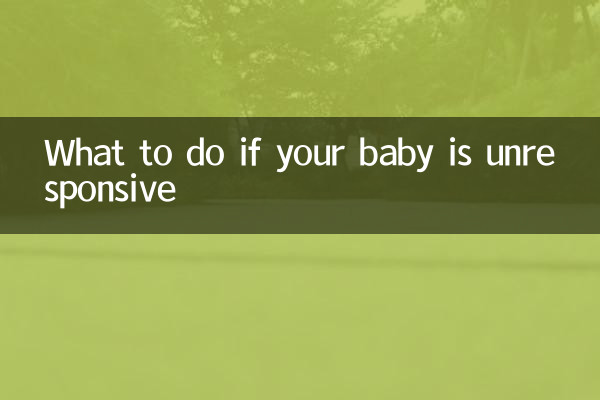What should I do if my baby is unresponsive? ——Analysis and solutions of hot topics across the Internet in 10 days
Recently, the topic of developmental delays and unresponsiveness in infants and young children has triggered widespread discussions on major parenting platforms and social media. Many parents are worried about whether their baby's reaction speed is normal and how to scientifically judge and intervene. This article combines the hotspot data of the entire network in the past 10 days to provide you with structured analysis and practical suggestions.
1. Statistics of hot topics across the entire network (last 10 days)

| platform | Related topics | amount of discussion | core concerns |
|---|---|---|---|
| #Is it normal for babies to ignore people# | 182,000 | Sluggish social responsiveness | |
| Tik Tok | "Baby's name shouldn't be called" related videos | 230 million views | auditory response test |
| little red book | Developmental Screening Guide | 14,000 notes | Home self-assessment method |
| Zhihu | cognitive development timeline | 6800+answers | Monthly age comparison standard |
2. Three dimensions of slow response to scientific judgments
1.Monthly age comparison table: According to WHO child development standards, there should be corresponding response performance at different months of age.
| age in months | normal reaction performance | early warning sign |
|---|---|---|
| 0-3 months | Staring at faces, startle reflex | No response to sound |
| 4-6 months | Actively grasp and find the source of sound | Not following moving objects |
| 7-12 months | Understand simple instructions and imitate actions | No response when called by name |
2.Home self-assessment method:
• Hearing test: Ring the bell alternately out of the baby’s sight (distance 30cm)
•Visual test: use the red ball to move left and right to observe and follow
• Tactile test: touch your palm lightly with objects made of different materials
3.Professional Assessment Process:
Child Health Department → Developmental Quotient Assessment → Griffiths Scale/Bailey Scale → Specialist consultation (if necessary)
3. Comparison of five popular intervention programs
| intervention method | Applicable situations | Effect cycle | Internet popularity |
|---|---|---|---|
| sensory training | Delayed development of vestibular sense | 3-6 months | ★★★★★ |
| Early education games | mild cognitive delay | 1-3 months | ★★★★☆ |
| language stimulation | Language comprehension lags behind | 2-4 months | ★★★☆☆ |
| Nutritional supplements | Caused by iron/zinc deficiency | 1-2 months | ★★☆☆☆ |
4. Three-step strategy recommended by experts
1.Troubleshoot basic issues
• Hearing screening (ABR test)
• Trace element detection
• Electroencephalogram (if necessary)
2.graded intervention plan
• Mild retardation: 30 minutes a day of targeted play (hide and find toys, clapping songs, etc.)
• Moderate retardation: 2-3 professional sensory training sessions per week + family strengthening
• Severe retardation: combined medical intervention + rehabilitation training program
3.Key points of environmental optimization
• Reduce electronic screen exposure (no exposure recommended for <2 years old)
• Increase face-to-face communication time (recommended >2 hours per day)
• Establish a routine (sleep is critical for neurodevelopment)
5. 5 hot issues that parents are most concerned about
1. Q: How many times does it count as abnormal if no response is given?
A: If there is no response in >50% of the times for 2 consecutive weeks, you need to be vigilant.
2. Q: Do you want to believe the old man who said "noble people speak late"?
A: There is a window period for language development, and it is difficult to make up for it if it is missed.
3. Q: How to judge the response standard of premature infants?
A: It should be evaluated based on corrected age in months (actual age in months - weeks of prematurity)
4. Q: Which toys can improve reaction speed?
A: Recommended cause and effect toys (press to make sounds) and multi-layer insert toys
5. Q: What materials should be prepared to register an expert account?
A: You need to bring:
• Growth video record
• Parenting diary
• Previous medical examination report
Conclusion:Data show that about 15% of infants and young children will have slow response in stages, but 80% of them can reach normal levels through early intervention. It is recommended that parents maintain rational observation, seize the golden intervention period of 1-3 years old, and avoid excessive anxiety. Regular child care follow-up is the scientific approach.

check the details

check the details